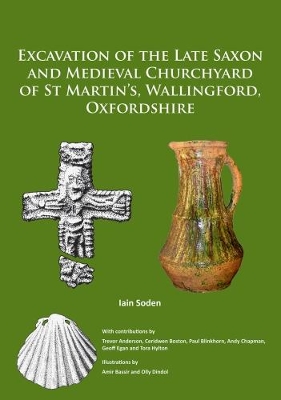
MOLA (Museum of London Archaeology) undertook excavations over 2003-4 at the former St Martin’s churchyard, Wallingford, Oxfordshire. St Martin’s, one of perhaps eight churches of late Saxon Wallingford, was located in a prominent position in the centre of the burh. No middle Saxon activity was found and the earliest remains consisted of a layer sealing the natural subsoil which contained a probable late Saxon lead cross. Earliest use of the churchyard has been dated to the late 10th to early 11th century by radiocarbon dating, and burials continued until the end of the 14th century, serving a dwindling parish population, before the cemetery rapidly fell out of use thereafter. No burials post-date 1412. Part of the cemetery has not been disturbed by the present development. The unexcavated areas and previous post-medieval and modern disturbances has meant the original size of the cemetery remains unknown. A late Saxon mortar mixer found on the site has added to a growing number of this distinctive early constructional feature. While its presence indicates the vicinity of the late Saxon church, no foundations of St Martin’s church appear to have survived cellar digging and quarrying for gravel that occurred in the early 18th century. Osteological analysis of 187 of the 211 excavated skeletons of the cemetery has depicted a lay population which was almost equally split between males and females, with only a slight bias towards males. Their distribution showed no observable cluster within the churchyard by age or gender. A high proportion of children is notable but newborns and very young children were comparatively rare. The significance of this is unclear since so many disarticulated remains were also present due to later disturbance. Both degenerative pathologies and inherited conditions affecting bone were noted, as were a high frequency of trauma, some of it violent. Generally the population could be shown to have led healthy early lives compared to other urban assemblages, although evidence of tuberculosis and iron deficiency suggest that living conditions and diet at the heart of medieval Wallingford were far from ideal. Within the excavated area of the cemetery, a number of the burials demonstrated known pre-Conquest burial rites and there are some aspects which may be peculiar to the area, suggesting local variations to common rites. Eight pre-Conquest burials had their heads supported mostly by stones, but one had his head supported by two disarticulated skulls. One 30-40 year old male was buried wearing a pierce scallop-shell, presumably a pilgrim badge from Santiago de Compostella. Four burials were interred in stone-built cists and these ranged from a c1 year old to adults of both sexes. A further six burials lay in stone-built cists without a cover. All post-Conquest burials were earth-cut examples.
| ISBN: | 9781784917661 |
| Publication date: | 31st January 2018 |
| Author: | Iain Soden |
| Publisher: | Archaeopress Archaeology an imprint of Archaeopress |
| Format: | Paperback |
| Pagination: | 94 pages |
| Genres: |
Archaeology by period / region |